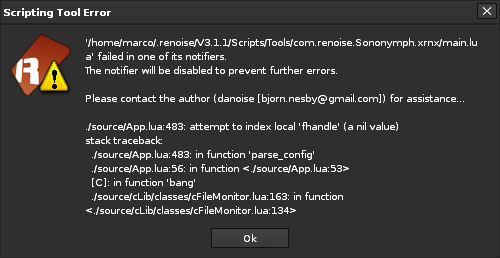Okay Meef, some things to mention. Firstly make sure you’ve run (and created a library etc) in Sononym (to create the query.json file in the .config/Sononym/ directory.) Also make sure that you type your paths (and filenames) 100% correctly first time in this tool (in fact what I’d do is uninstall this tool, reinstall the tool and start from scratch.)
Unfortunately it’s still the same for me. Uninstalled the tool, deleted my sononym directory, added a library, used the library, reinstalled the tool, set the paths and still says I need a valid config path. What was the other fix?
I also get an error message when the auto activate feature is enabled:

and RENOISE also freezes
Thanks I’ll try what you did! 
Weird, I just went back to check my paths were indeed correct and before I changed anything it was working. Cool, thanks for the tips 4tey. Still would be nice to have drag and drop though.
Now it works! Thanks a lot! The trick was to give the pass to exe as
/home/marco/sononym-1.0.4/sononym
where the last “sononym” points to the program.
Great 
Renoise freezes when Sononym is closed and you start Sononym from the Sononym Integration Renoise-Tool. When you close Sononym Renoise is unfreezed again.
When starting sononym by hand from the terminal it works.
Might be because os.execute is blocking (with Linux). You could specify os.execute(“/path/to/program/sononym &”) to execute the process in the background.
Renoise freezes when Sononym is closed and you start Sononym from the Sononym Integration Renoise-Tool. When you close Sononym Renoise is unfreezed again.
The way the tool currently works, this is to be expected: you need to start Sononym before making use of the tool. This is explained in a “show-once” dialog, but might indeed not be sufficiently clear.
You could specify os.execute(“/path/to/program/sononym &”) to execute the process in the background.
Woot, interesting. I’m definitely no linux expert - the ampersand is doing what, exactly?
It will fork and execute the process in the background for you, so the os.execute call won’t block. You can see the effect simply. If you ever run a unix style os danoise you can try it yourself. Under a bash shell if I type:
$ ./sononymThis will start Sononym, but (naturally) notice that it won’t return control back to the shell until the user quits Sononym. However if I write:
$ ./sononym &The shell will now start and fork Sononym, so it will immediately return control back to the shell and you will have Sononym running** ![]()
Bit of trivia: The Amiga Workbench shell/cli had a similar mechanism using a command called ‘Run’ AmigaOS Manual: AmigaDOS Command Reference - AmigaOS Documentation Wiki
** Note that any stdout messages output from Sononym will also be mixed into the terminal shell ![]()
Thanks for the answers, I didn’t have time to make a test.
Found another issue with the sononym integrations tool.
I have my samples located in /home/marco/Samples
Everything is working fine when I’m in the Libraries view in sononym and the tool shows me as path Explore:/home/marco/samples/
But when I change to explore in sononym I get only Library:/home/ in the integration tool and my samples are not found as they are in /home/marco.
question, what happens if you’ve set the sample in renoise to say transpose -6.
if you replace the sample, are the sample settings (transpose -6 for instance)… kept?
Yes, they are.
PS: And with this release out of the door, I’m also looking forward to finishing the Sononymph tool
![]()
Just wanted to say that this tool makes sononym a dangerous tool in the arsenal. So much fun and very easy to use. Looking forward to the update!
just for me to find again:
path to exe: /home/marco/sononym-1.2.1/sononym
path to config /home/marco/.config/Sononym/query.json
Woah!! I wanted to try Sononym, but didn’t want the hassle of using something external. Having it integrated is making it a lot more enticing for me!!! Nice work, man!
Did this stop working with sononym 1.2.1?
Can’t use the ‘search in sononym’ option in the tool, though the ’ transfer to Renoise’ option does seem to work. Have manually browsed to the correct folders for the different paths needed in the tool to no avail (yet?).
Apparently, on Windows it did - will be fixed, of course!